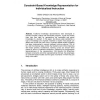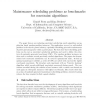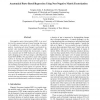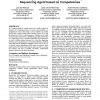476 search results - page 25 / 96 » Learning When to Use Lazy Learning in Constraint Solving |
NIPS
2007
13 years 9 months ago
2007
When we have several related tasks, solving them simultaneously is shown to be more effective than solving them individually. This approach is called multi-task learning (MTL) and...
COMSIS
2006
13 years 7 months ago
2006
Traditional knowledge representations were developed to encode complete, explicit and executable programs, a goal that makes them less than ideal for representing the incomplete an...
AMAI
1999
Springer
13 years 7 months ago
1999
Springer
The paper focuses on evaluating constraint satisfaction search algorithms on application based random problem instances. The application we use is a well-studied problem in the el...
CVPR
2010
IEEE
14 years 21 days ago
2010
IEEE
Non-negative matrix factorization (NMF) is an excellent tool for unsupervised parts-based learning, but proves to be ineffective when parts of a whole follow a specific pattern. ...
GECCO
2008
Springer
13 years 8 months ago
2008
Springer
In e-learning initiatives content creators are usually required to arrange a set of learning resources in order to present them in a comprehensive way to the learner. Course mater...




